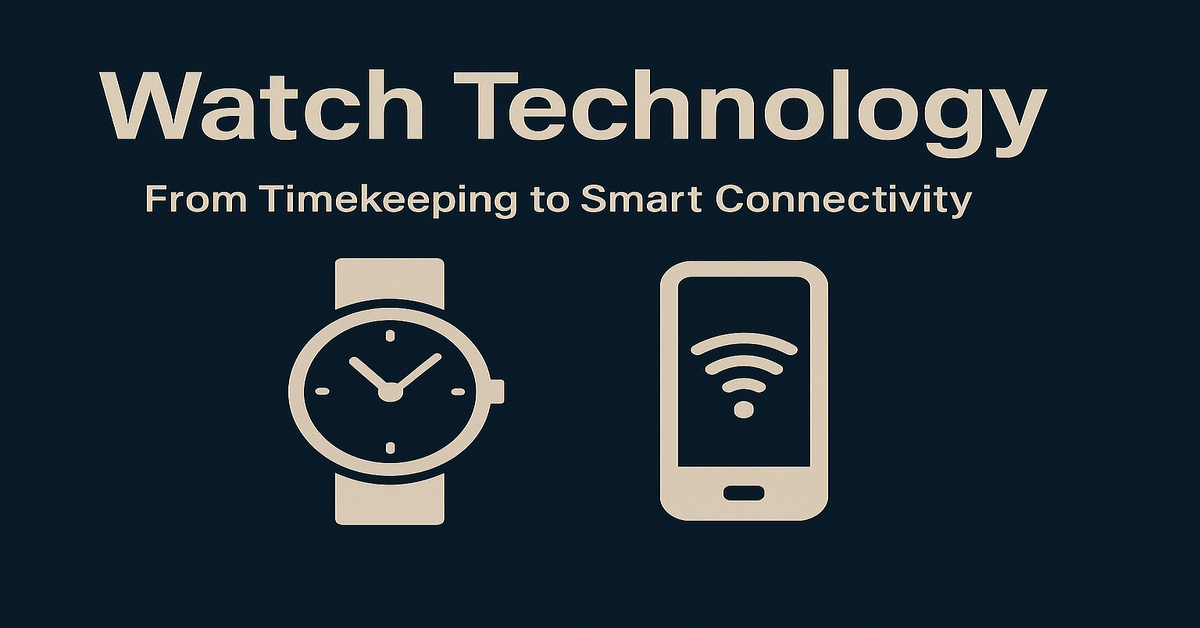Watches have always been more than devices that tell time. They are statements of personal style, symbols of precision engineering, and, more recently, digital hubs that connect us to the world. The journey of watch technology—from the sundials of ancient times to the advanced smartwatches of today—is a testament to human ingenuity and the relentless pursuit of convenience and innovation.
A Brief History of Timekeeping
Ancient Origins
The earliest attempts at timekeeping included sundials and water clocks, used in civilizations like Egypt and Mesopotamia. These early tools laid the groundwork for mechanical advancements that would revolutionize horology.
The Mechanical Watch Revolution
Mechanical watches emerged in the 15th century, powered by gears, springs, and escapements. These masterpieces of craftsmanship dominated timekeeping for centuries and are still revered by collectors and enthusiasts.
Quartz Movement: A Technological Breakthrough
In the 1960s, quartz watches transformed the industry by introducing a more accurate and less expensive way to keep time. The use of electronic oscillators powered by batteries allowed quartz watches to outperform mechanical counterparts in precision.
Modern Watch Categories
Analog Watches
These traditional timepieces use hour, minute, and second hands to display time. They can be mechanical or quartz and often feature complications such as date windows or chronographs.
Digital Watches
Digital watches use LCD or LED screens to display time and often include multiple functions like alarms, stopwatches, backlights, and calendars.
Hybrid Watches
Combining analog aesthetics with digital functions, hybrid watches are designed for users who want the best of both worlds. They often offer step tracking, notifications, and basic connectivity without full smart capabilities.
Smartwatches
The pinnacle of modern watch technology, smartwatches connect to smartphones and integrate features like:
- Fitness and health tracking
- GPS and navigation
- Communication (calls, messages, emails)
- App integration
Innovations in Watch Technology
Materials and Durability
From stainless steel and titanium to ceramic and sapphire crystal, material science has evolved to make watches:
- More durable
- Water-resistant
- Scratch-resistant
- Lightweight and comfortable
Power Sources
Battery life has long been a concern for wearable tech. Innovations include:
- Solar-powered watches
- Kinetic movement energy
- Long-lasting lithium batteries
- Wireless and magnetic charging docks for smartwatches
Connectivity
Modern smartwatches support:
- Bluetooth for pairing with phones
- Wi-Fi for data syncing
- Cellular LTE for standalone functionality
These connectivity options allow users to stream music, receive notifications, and track fitness without carrying a smartphone.
Health and Fitness Tracking
Smartwatches now come equipped with sensors to measure:
- Heart rate
- Oxygen levels (SpO2)
- Sleep cycles
- ECG and stress levels
- Step count and calorie burn
This has transformed watches into valuable tools for health monitoring.
Key Players in Watch Technology
Traditional Brands
Legacy brands like Rolex, Omega, Seiko, and Tag Heuer continue to lead in craftsmanship and innovation within analog and hybrid watches.
Tech Giants
Companies like Apple, Samsung, Garmin, and Fitbit dominate the smartwatch segment. Each brand brings unique features tailored to different lifestyles, from athletics to productivity.
Luxury Smartwatches
Brands like Montblanc and Hublot have entered the smart category, offering premium smartwatches that blend traditional luxury aesthetics with digital functions.
Impact of Watch Technology on Society
Lifestyle and Convenience
Watches have evolved from passive accessories to active digital assistants. They allow for hands-free operation, enhance productivity, and promote wellness.
Professional Applications
Specialized watches cater to:
- Pilots (aviator watches)
- Divers (depth-resistant diving watches)
- Military personnel (tactical watches)
- Athletes (sports watches with biometric feedback)
Fashion and Identity
Whether it’s a sleek Apple Watch, a rugged G-Shock, or a minimalist analog piece, watches reflect personality, values, and lifestyle.
Future Trends in Watch Technology
AI Integration
Artificial intelligence will likely enable:
- Smarter health insights
- Predictive alerts
- Behavioral adaptation (e.g., suggestions based on activity patterns)
Sustainable Design
The push for environmental sustainability is driving innovation in:
- Recycled materials
- Energy-efficient components
- Eco-conscious packaging
Augmented Reality and Holographics
Concept designs include smartwatches that:
- Project holograms
- Offer AR experiences
- Replace traditional screens with immersive displays
Enhanced Personalization
Upcoming watches may use biosignals to auto-adjust:
- Display brightness
- Notification priority
- Recommended activity goals
Challenges in Watch Technology
Battery Limitations
Despite advancements, battery life remains a bottleneck, especially in feature-rich smartwatches.
Data Privacy
With more personal data being collected (health, location), privacy and cybersecurity are critical concerns.
Interoperability
Users want seamless integration across platforms, but different operating systems and ecosystems can cause compatibility issues.
Buying Guide: Choosing the Right Watch
For Everyday Use
Opt for:
- Smartwatches with long battery life
- Water resistance
- Fitness tracking features
For Fitness Enthusiasts
Look for:
- GPS
- Heart rate and VO2 max tracking
- Workout mode customizations
For Style Seekers
Consider:
- Analog or hybrid watches with premium materials
- Customizable watch faces
- Luxury branding
For Tech Aficionados
Choose:
- Feature-rich smartwatches
- App compatibility
- Customizable notifications
Conclusion
Watch technology has undergone a remarkable transformation—from ancient sundials to futuristic smartwatches that track your sleep, call your friends, and monitor your health. As innovation continues, the wristwatch remains one of the most versatile and evolving accessories in human history.
It’s not just about telling the time anymore. It’s about enhancing the way we live, move, and connect.
FAQs
1. What’s the difference between a smartwatch and a hybrid watch?
A smartwatch offers full digital capabilities and app integration, while a hybrid watch combines analog design with limited smart features.
2. Are smartwatches suitable for medical use?
Some smartwatches offer medical-grade ECG and SpO2 features, but they should complement—not replace—professional healthcare advice.
3. How accurate are fitness trackers on watches?
They are generally accurate for casual users but may vary slightly compared to specialized medical devices.
4. Do smartwatches work without a smartphone?
Some smartwatches with LTE or Wi-Fi connectivity can function independently for calls, messages, and streaming.
5. What is the best smartwatch for Android users?
Popular choices include Samsung Galaxy Watch series, Google Pixel Watch, and Garmin for fitness-focused users.
6. Can traditional watch brands compete with tech giants?
Yes, many traditional brands now offer hybrid or luxury smartwatches, blending heritage with modern features.











